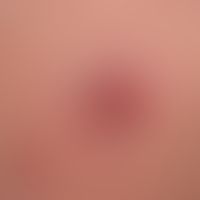Image diagnoses for "Nodule (<1cm)", "red"
183 results with 595 images
Results forNodule (<1cm)red

Acne excoriée L70.8

Lip carcinoma C00.0-C00.1
Carcinoma of the lips : Wide, firm, painless, warty, eroded and ulcerated plaque of the lower lip in a 75 year old pipe smoker.

Fibrokeratome acquired digital D23.L
Fibrokeratome, acquired digital. benign, mainly on the fingers, more rarely on the toes, very slowly growing exophytic tumor of the adult with consecutive, displacing nail dystrophy. numerous Beau-Reils transverse furrows as a sign of intermittent growth disturbance.

Mycosis fungoid tumor stage C84.0
Mycosis fungoides tumor stage: Mycosis fungoides has been known for many years, and for several months there has been a continuous occurrence of plaques and nodules on the face and upper extremity.

Neurofibromatosis peripheral Q85.0
Neurofibromatosis peripheral: multiple differently sized soft, broad-based, painless reddish to reddish-brown, surface-smooth papules and nodules.

Basal cell carcinoma nodular C44.L
Basal cell carcinoma, nodular. solitary, 0.8 x 10.8 cm in size, broad-based, firm, painless papule, with a shiny, smooth parchment-like surface covered by ectatic, bizarre vessels. Note: There is no follicular structure on the surface of the papules.

Anal carcinoma C44.5

Leprosy lepromatosa A30.50

Squamous cell carcinoma of the skin C44.-
Squamous cell carcinoma in actinic pre-damaged scalp:Continuously growing verrucous, broad-based, hard node of the scalp, existingfor severalmonths; multiple actinic keratoses.

Squamous cell carcinoma of the skin C44.-
Squamous cell carcinoma of the skin: large, painless, flat ulcerated lump, still movable above the base.

Lymphomatoids papulose C86.6
Lymphomatoid papulosis: pea- to bean-sized papules with central hemorrhagic-necrotizing transformation in the hollow of the knee in a 56-year-old woman.

Angiokeratoma circumscriptum D23.L
Angiokeratoma circumscriptum. localized vascular malformation with bizarre blue-black papular and nodular lesions. no symptoms. increasing prominence of the herd in recent years.

Hidradenoma nodular D23.L

Squamous cell carcinoma of the skin C44.-
Squamous cell carcinoma of the skin: solitary, since 1 year continuously growing, 2.2 cm large, sharply defined, asymptomatic, grey, rough lump with central ulceration and crusts.

Basal cell carcinoma (overview) C44.-
Basal cell carcinoma nodular: Irregularly configured, hardly painful, borderline red nodule (here the clinical suspicion of a basal cell carcinoma can be raised: nodular structure, shiny surface, telangiectasia); extensive decay of the tumor parenchyma in the center of the nodule.

Merkel cell carcinoma C44.L
Merkel cell carcinoma, a lesscharacteristically fielded, surface smooth, completely asymptomatic lump that has grown rapidly in recent weeks.

Infant haemangioma (overview) D18.01

Lymphomatoids papulose C86.6
Lymphomatoid papulosis: chronic, relapsing, completely asymptomatic clinical picture with multiple, 0.3 - 1.2 cm large, flat, scaly papules and nodules as well as ulcers. 35-year-old, otherwise healthy man

Squamous cell carcinoma of the skin C44.-
Subungual squamous cell carcinoma: The slowly growing (> 2 years) verrucous nodule, which was initially interpreted as a "wart", had grown from the subungual zone to the tip of the thumb and the entire subugual nail area during this time. In the meantime painful suppurations of the nail bed occurred repeatedly.





